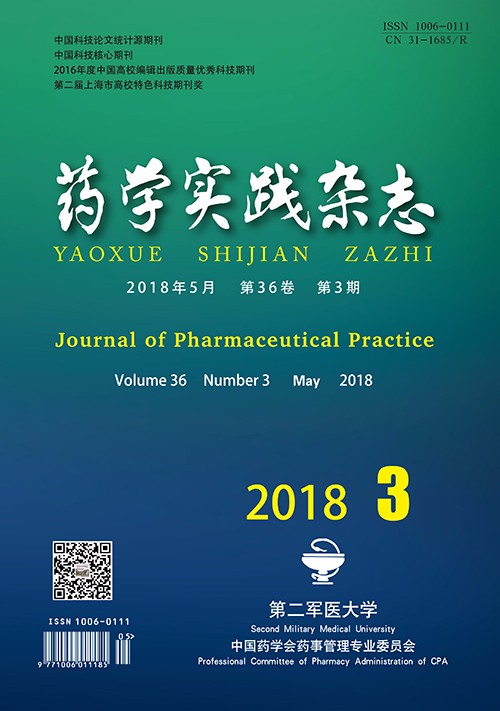XIE Hua, WANG Yanling, WANG Chang, LI Wenbin, JIA Zhengping, WANG Rong. The protective effects of metoprolol on rat myocardium at 3 400 m[J]. Journal of Pharmaceutical Practice and Service, 2018, 36(3): 238-242. doi: 10.3969/j.issn.1006-0111.2018.03.010
| Citation:
|
XIE Hua, WANG Yanling, WANG Chang, LI Wenbin, JIA Zhengping, WANG Rong. The protective effects of metoprolol on rat myocardium at 3 400 m[J]. Journal of Pharmaceutical Practice and Service, 2018, 36(3): 238-242. doi: 10.3969/j.issn.1006-0111.2018.03.010
|
The protective effects of metoprolol on rat myocardium at 3 400 m
- Received Date: 2018-02-23
- Rev Recd Date:
2018-04-04
-
Abstract
Objective To investigate the effects on myocardial mitochondria-related indexes in rats after rapid elevation to 3 400 m altitude and myocardial protection effects with metoprolol. Methods Male Wistar rats were randomly divided into three groups with 12 rats in each group as follows, group A (normal group, 55 m above sea level), group B (hypoxia group, 3 400 m above sea level), group C (metoprolol group, 3 400 m above sea level). Heart rate and blood pressure were measured during the rapid transfer from the plain (Shanghai 55 m) to plateau of 3 400 m. Then, the rats were anesthetized with chloral hydrate. The blood was collected from the abdominal aorta and blood gas indexes were measured. The heart tissue was homogenized. The oxidativee stress related parameters, such as superoxide dismutase (SOD), malondialdehyde (MDA) and nitric oxide (NO) were assayed. The mitochondrial function related parameters, such as complexes-Ⅰ, Ⅱ, Ⅲ, Ⅳ, succinate dehydrogenase (SDH), malate dehydrogenase (MDH) and adenosine triphosphate (ATP) were measured. Results After the rats were exposed to high altitude, the blood oxygen tension and oxygen saturation in the metoprolol group were increased in comparison with the hypoxia group. Compared with the normal group, the content of MDA in the hypoxia group was increased significantly, while the content of SOD and NO were decreased significantly (P<0.01), the mitochondrial complex Ⅰ, Ⅱ, Ⅲ and Ⅳ were also decreased 44.49%, 32.38%, 34.43% and 20.16%. Compared with hypoxia group, the MDA was decreased by 13.72%, while SOD and NO were increased by 25.73% and 168.55%, the activity of mitochondrial complexes were also increased by 44.92%, 33.73%, 37.11% and 10.09% for metoprolol group. The respiratory chain SDH and MDH in hypoxic group were decreased by 29.51% and 42.79% and the activity of Na+-K+-ATPase, Ca2+-Mg2+-ATPase and T-ATPase were decreased by 20.24%, 27.56% and 33.32% in comparison with the normal group. After intervention with metoprolol, SDH and MDH were increased by 47.36% and 88.57% separately, the activities of Na+-K+-ATPase, Ca2+-Mg2+-ATPase and T-ATPase were also increased by 31.92%, 26.95%, 44.93% in comparison with hypoxia group. Those results indicated that metoprolol can increase ATPase activity. Conclusion Under the condition of acute hypoxia at 3 400 m above sea level, myocardial injury is related to the changes of oxidative stress and mitochondrial-related enzyme activity. Metoprolol helps to normalize the related indicators and provides the protection for myocardial injury caused by hypoxia.
-
References
|
[1]
|
Higgins JP, Tuttle T, Higgins JA. Altitude and the heart:Is going high safe for your cardiac patient?[J]. Am Heart J,2010, 159(1):25-32. |
|
[2]
|
Vigo DE, Pérez Lloret S, Videla AJ, et al. Heart rate nonlinear dynamics during sudden hypoxia at 8230 m simulated altitude[J]. Wilderness Environ Med,2010, 21(1):4-10. |
|
[3]
|
Salama SA, Omar HA, Maghrabi IA, et al. Iron supplementation at high altitudes induces inflammation and oxidative injury to lung tissues in rats[J]. Toxicol Appl Pharmacol,2014, 274(1):1-6. |
|
[4]
|
Wold LE, Ceylan-Isik AF, Ren J. Oxidative stress and stress signaling:menace of diabetic cardiomyopathy[J]. Acta Pharmacol Sin,2005, 26(8):908-917. |
|
[5]
|
Radák Z, Asano K, Fu Y, et al. The effect of high altitude and caloric restriction on reactive carbonyl derivatives and activity of glutamine synthetase in rat brain[J]. Life Sci,1998, 62(15):1317-1322. |
|
[6]
|
Bhagat R, Yasir A, Vashisht A, et al. High altitude simulation, substance P and airway rapidly adapting receptor activity in rabbits[J]. Respir Physiol Neurobiol,2011, 178(2):329-336. |
|
[7]
|
Skulachev VP. Cationic antioxidants as a powerful tool against mitochondrial oxidative stress[J]. Biochem Biophys Res Commun,2013, 441(2):275-279. |
|
[8]
|
赵伟, 孙国志. 不同种实验动物间用药量换算[J]. 畜牧兽医科技信息, 2010(5):39-45. |
|
[9]
|
Kumar D, Rizvi SI. A critical period in lifespan of male rats coincides with increased oxidative stress[J]. Arch Gerontol Geriatr,2014, 58(3):427-433. |
|
[10]
|
张龙翔. 生化实验方法和技术[M]. 2版.北京:高等教育出版社, 1997. |
|
[11]
|
Solinas P, Fujioka H, Radivoyevitch T, et al. Aging effects on oxidative phosphorylation in rat adrenocortical mitochondria[J]. Mech Ageing Dev,2014(138):10-14. |
|
[12]
|
Gouspillou G,Hepple RT. Facts and controversies in our understanding of how caloric restriction impacts the mitochondrion[J]. Exp Gerontol,2013,48(10):1075-1084. |
|
[13]
|
Xiong JW, Zhu LP, Jiao XM, et al. Evidence for ΔpH surface component (ΔpHS) of proton motive force in ATP synthesis of mitochondria[J]. Biochim Biophys Acta,2010, 1800(3):213-222. |
|
[14]
|
Hua JS, Li LP, Zhu XM. Effects of moxibustion pretreating on SOD and MDA in the rat of global brain ischemia[J]. J Tradit Chin Med, 2008, 28(4):289-292. |
|
[15]
|
Sasaki H, Ray PS, Zhu L, et al. Oxidative stress due to hypoxia/reoxygenation induces angiogenic factor VEGF in adult rat myocardium:possible role of NFκB[J]. Toxicology,2000, 155(1-3):27-35. |
|
[16]
|
Dröse S. Differential effects of complex Ⅱ on mitochondrial ROS production and their relation to cardioprotective pre-and postconditioning[J]. Biochim Biophys Acta, 2013, 1827(5):578-527. |
|
[17]
|
王延玲, 王荣, 杨锁泉, 等.急进不同低海拔环境对大鼠心肌的影响[J]. 南方医科大学学报, 2014(3):312-316. |
|
[18]
|
黄立双, 刘伟丽, 弓景波, 等. 多沙唑嗪和美托洛尔对腹主动脉缩窄致高血压大鼠血管重塑的影响[J]. 中国药理学与毒理学杂志, 2015, 29(2):208-212. |
-
-
Proportional views

-







 DownLoad:
DownLoad: